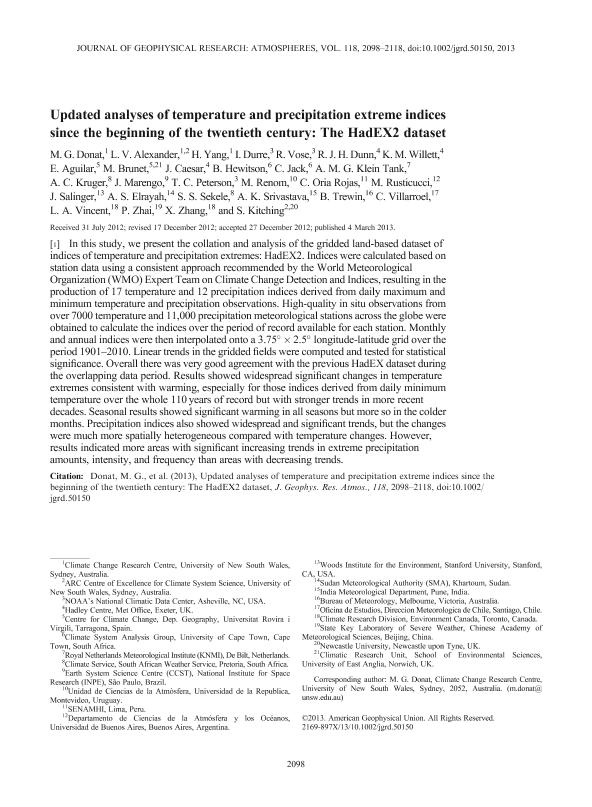Artículo
Updated analyses of temperature and precipitation extreme indices since the beginning of the twentieth century: The HadEX2 dataset
Donat, M. G.; Alexander, L. V.; Yang, H.; Durre, I.; Vose, R.; Dunn, R. J. H.; Willett, K. M.; Aguilar, E.; Brunet, M.; Caesar, J.; Hewitson, B.; Jack, C.; Klein Tank, A. M. G.; Kruger, A. C.; Marengo, J.; Peterson, T. C.; Renom, M.; Oria Rojas, C.; Rusticucci, Matilde Monica ; Salinger, J.; Elrayah, A. S.; Sekele, S. S.; Srivastava, A. K.; Trewin, B.; Villarroel, C.; Vincent, L. A.; Zhai, P.; Zhang, X.; Kitching, S.
; Salinger, J.; Elrayah, A. S.; Sekele, S. S.; Srivastava, A. K.; Trewin, B.; Villarroel, C.; Vincent, L. A.; Zhai, P.; Zhang, X.; Kitching, S.
 ; Salinger, J.; Elrayah, A. S.; Sekele, S. S.; Srivastava, A. K.; Trewin, B.; Villarroel, C.; Vincent, L. A.; Zhai, P.; Zhang, X.; Kitching, S.
; Salinger, J.; Elrayah, A. S.; Sekele, S. S.; Srivastava, A. K.; Trewin, B.; Villarroel, C.; Vincent, L. A.; Zhai, P.; Zhang, X.; Kitching, S.
Fecha de publicación:
03/2013
Editorial:
American Geophysical Union
Revista:
Journal of Geophysical Research Atmospheres
ISSN:
0148-0227
Idioma:
Inglés
Tipo de recurso:
Artículo publicado
Clasificación temática:
Resumen
In this study, we present the collation and analysis of the gridded land-based dataset of indices of temperature and precipitation extremes: HadEX2. Indices were calculated based on station data using a consistent approach recommended by the World Meteorological Organization (WMO) Expert Team on Climate Change Detection and Indices, resulting in the production of 17 temperature and 12 precipitation indices derived from daily maximum and minimum temperature and precipitation observations. High-quality in situ observations from over 7000 temperature and 11,000 precipitation meteorological stations across the globe were obtained to calculate the indices over the period of record available for each station. Monthly and annual indices were then interpolated onto a 3.75° × 2.5° longitude-latitude grid over the period 1901-2010. Linear trends in the gridded fields were computed and tested for statistical significance. Overall there was very good agreement with the previous HadEX dataset during the overlapping data period. Results showed widespread significant changes in temperature extremes consistent with warming, especially for those indices derived from daily minimum temperature over the whole 110 years of record but with stronger trends in more recent decades. Seasonal results showed significant warming in all seasons but more so in the colder months. Precipitation indices also showed widespread and significant trends, but the changes were much more spatially heterogeneous compared with temperature changes. However, results indicated more areas with significant increasing trends in extreme precipitation amounts, intensity, and frequency than areas with decreasing trends.
Archivos asociados
Licencia
Identificadores
Colecciones
Articulos(OCA CIUDAD UNIVERSITARIA)
Articulos de OFICINA DE COORDINACION ADMINISTRATIVA CIUDAD UNIVERSITARIA
Articulos de OFICINA DE COORDINACION ADMINISTRATIVA CIUDAD UNIVERSITARIA
Citación
Donat, M. G.; Alexander, L. V.; Yang, H.; Durre, I.; Vose, R.; et al.; Updated analyses of temperature and precipitation extreme indices since the beginning of the twentieth century: The HadEX2 dataset; American Geophysical Union; Journal of Geophysical Research Atmospheres; 118; 5; 3-2013; 2098-2118
Compartir
Altmétricas



